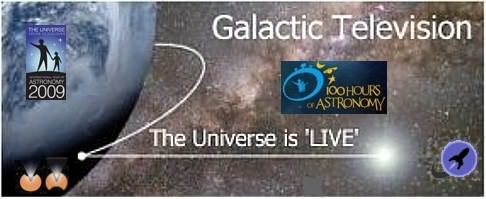Attention Universe Today Readers! “100 Hours of Astronomy” is about to begin and we’ve got a very special gift just for you. How would you like to decide where to aim our IYA remote telescope? While Saturday, April 3, celebrates the global Star Party where many telescopes (both remote and live) will be open to the public, we couldn’t help but wonder about those who might not be able to make it out, didn’t live near an event – or had bad weather. So, we decided to do something about it. Rather than only give you the 100 hours of telescope time over the next few days, we’re going to give you 100 hours of IYA remote telescope targeting choices and only start the clock ticking when the sky is clear and the scope is running! Are you ready to choose your coordinates and save your astrophoto to show to the world? Then grab your star charts and step inside for some instructions…
Beginning at 9:00 UT on April 2, 2009 the IYA “Galactic TV” Remote Telescope located in the southern hemisphere will be yours when it comes to choice of objects for viewing. If you’ve ever wondered what a particular NGC looks like – then now is your chance to find out! However, you’ll need to remember that this is a “real” telescope with real limitations working from a real sky… and that means doing a little astronomical homework on your part. Are you ready to begin? Good!!
For those of us familiar with northern hemisphere skies, this means totally reversing the way we think. The ecliptic plane will now be to the north, positioned approximately 60 degrees above the horizon from our telescope’s point of view and the southern pole will be positioned roughly 40 degrees above the horizon. This means that constellations familiar to us – like Orion – will begin past the meridian to the high west at nightfall. Good constellations to choose objects from (for example) would be Carina, Vela, Crux, Centaurus, Circinus, Pavo, Indus, Tucana, Hydra, Lupus, Pices Austrinus and Scorpius. But, don’t forget that we share common sky, too! Anything rising to the east can also be seen.
The next step in choosing a target is what our telescope is capable of. When it comes to field of view, you’re in luck at a full degree of “eyepiece space”. This means that anything that measures 60 arc minutes or less in size will fit inside the camera screen with ease. You will need to choose your object by magnitude as well. During perfect dark sky conditions our 80mm telescope can achieve around magnitude 8 deep sky (such as galaxies and nebulae), but remember… there will be Moon present for at least part of the evening. This will limit what the telescope can “see” at a particular time. While the Moon is out, choose bright open star clusters and save galaxies or nebula for the hours before dawn. Also remember our telescope is very small, so it has a limited resolution factor – it won’t be able to split very close double stars.
Now… Are you ready for the fun part?! All you have to do is post your object request here. You don’t need to be an astronomer, know how to operate a telescope or how to control astrophotography equipment to enjoy our IYA remote scope! Just post the common name (like Eta Carinae), OR catalog number (such as NGC 2516, Messier, IC or others) of your request, OR type in the coordinates (RA and Dec), add your name and location, and the Southern Galactic Telescope Hosting Facility will take care of the rest. When your object is targeted, here is what your screen will look like:

So what happens if you’re not home or at your computer when your request appears? Not to worry. We thought of that, too. Southern Galactic has kindly agreed to take a photo snap of your screen and save it for you! Because this wonderful project is meant to inspire everyone around the world to use a telescope, we’ll save these images and post the collection every few days for the duration of the 100 hours of the IYA remote telescope event and folks everywhere will have an opportunity to enjoy the target you have chosen and to see who selected it.
We’ll honor as many requests as possible each night – allowing ample viewing time for each object, take your snapshot for the library and select one as the video of the day. Some may appear before others depending on the position or magnitude demands, but we’ll do our very best to give you all you ask for. So what are you waiting for? Get your star charts out and start posting your requests here right now!
Our many thanks to the Southern Galactic Remote Telescope Hosting Facility for the extremely generous donation of your time to make this wonderful project happen!




